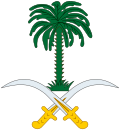This article needs additional citations for verification .(April 2025) |
Third Saudi State | |||||||||||||||||
|---|---|---|---|---|---|---|---|---|---|---|---|---|---|---|---|---|---|
| Motto: لا إله إلا الله، محمد رسول الله Lā ilāha illa allāh, Muḥammadun rasūlu allāh "There is no god but Allah, Muhammad is the Messenger of God" [1] [a] ( shahada ) | |||||||||||||||||
| Anthem: النشيد الوطني السعودي "an-Našīd al-Waṭaniyy as-Suʿūdiyy" "Chant of the Saudi Nation" | |||||||||||||||||
 | |||||||||||||||||
| Capital and largest city | Riyadh 24°39′N46°46′E / 24.650°N 46.767°E | ||||||||||||||||
| Official languages | Arabic [5] | ||||||||||||||||
| Common languages | Arabic | ||||||||||||||||
| Religion | Sunni Islam (official) [6] | ||||||||||||||||
| Demonym(s) |
| ||||||||||||||||
| Government | Islamic absolute monarchy | ||||||||||||||||
| History | |||||||||||||||||
| 13 January | |||||||||||||||||
| April 1913 | |||||||||||||||||
| 2 November 1921 | |||||||||||||||||
| 8 January 1926 | |||||||||||||||||
• Saudi Arabia established | 23 September | ||||||||||||||||
| |||||||||||||||||
The Third Saudi state is the heir to the two earlier Saudi states: the first and the second, founded by Abdul Aziz bin Abdul Rahman (also known as "Ibn Saud"), who managed to capture the city of Riyadh on January 13, 1902. A long series of conflicts and conquests ultimately led to the establishment of the modern and contemporary Saudi state, the Kingdom of Saudi Arabia.

